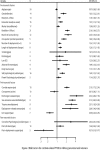A meta-analysis of risk factors for combat-related PTSD among military personnel and veterans
- PMID: 25793582
- PMCID: PMC4368749
- DOI: 10.1371/journal.pone.0120270
A meta-analysis of risk factors for combat-related PTSD among military personnel and veterans
Abstract
Post-traumatic stress disorder (PTSD), a complex and chronic disorder caused by exposure to a traumatic event, is a common psychological result of current military operations. It causes substantial distress and interferes with personal and social functioning. Consequently, identifying the risk factors that make military personnel and veterans more likely to experience PTSD is of academic, clinical, and social importance. Four electronic databases (PubMed, Embase, Web of Science, and PsycINFO) were used to search for observational studies (cross-sectional, retrospective, and cohort studies) about PTSD after deployment to combat areas. The literature search, study selection, and data extraction were conducted by two of the authors independently. Thirty-two articles were included in this study. Summary estimates were obtained using random-effects models. Subgroup analyses, sensitivity analyses, and publication bias tests were performed. The prevalence of combat-related PTSD ranged from 1.09% to 34.84%. A total of 18 significant predictors of PTSD among military personnel and veterans were found. Risk factors stemming from before the trauma include female gender, ethnic minority status, low education, non-officer ranks, army service, combat specialization, high numbers of deployments, longer cumulative length of deployments, more adverse life events, prior trauma exposure, and prior psychological problems. Various aspects of the trauma period also constituted risk factors. These include increased combat exposure, discharging a weapon, witnessing someone being wounded or killed, severe trauma, and deployment-related stressors. Lastly, lack of post-deployment support during the post-trauma period also increased the risk of PTSD. The current analysis provides evidence of risk factors for combat-related PTSD in military personnel and veterans. More research is needed to determine how these variables interact and how to best protect against susceptibility to PTSD.
Conflict of interest statement
Figures
References
-
- Association Psychiatric Assocaition (1994) Diagnostic and statistical manual of mental disorders (4th ed.). Washington, DC: Author.
-
- Beckham JC, Lytle BL, Vrana SR, Hertzberg MA, Feldman ME, Shipley RH (1996) Smoking withdrawal symptoms in response to a trauma-related stressor among Vietnam combat veterans with posttraumatic stress disorder. Addictive behaviors 21: 93–101. - PubMed
-
- Brewin CR, Andrews B, Valentine JD (2000) Meta-analysis of risk factors for posttraumatic stress disorder in trauma-exposed adults. Journal of consulting and clinical psychology 68: 748–766. - PubMed
-
- Dohrenwend BP, Turner JB, Turse NA, Adams BG, Koenen KC, Marshall R (2007) Continuing controversy over the psychological risks of Vietnam for U.S. veterans. Journal of traumatic stress 20: 449–465. - PubMed
-
- Hoge CW, Castro CA, Messer SC, McGurk D, Cotting DI, Koffman RL (2004) Combat duty in Iraq and Afghanistan, mental health problems, and barriers to care. The New England journal of medicine 351: 13–22. - PubMed
Publication types
MeSH terms
LinkOut - more resources
Full Text Sources
Other Literature Sources
Medical



